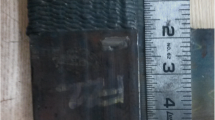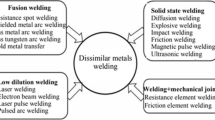Abstract
Dissimilar metal welds (DMWs) are routinely used in the oil and gas industries for structural joining of high-strength steels to eliminate the need for post-weld heat treatment (PWHT) in field welding. Hydrogen-assisted cracking (HAC) can occur in DMWs during subsea service under cathodic protection. DMWs of two material combinations, 8630 steel/FM 625 and F22 steel/FM 625, produced with two welding procedures, non-temper bead (BS1) and temper bead (BS3), in the as-welded and PWHT conditions were investigated in this study. These DMWs were subjected to metallurgical characterization and testing with the delayed hydrogen cracking test (DHCT) to identify the effects of base metal composition, welding and PWHT procedures on their HAC susceptibility. The HAC susceptibility was ranked using the time to failure in the DHCT at loads equivalent to 90% of the base metal yield strength (YS) and the apparent stress threshold for HAC. A criterion for resistance to HAC in the testing conditions of DHCT was also established. The results of this study showed that 8630/FM 625 DMWs were more susceptible to HAC than the F22/FM 625 DMWs. PWHT did not sufficiently reduce the HAC susceptibility of the 8630/FM 625 and F22/FM 625 BS1 welds. DMWs produced using BS3 performed better than BS1 DMWs. The post-weld heat-treated F22/FM 625 BS3 DMW passed the HAC resistance criterion.



















Similar content being viewed by others
References
Beachem CD (1972) A new model for hydrogen-assisted cracking (hydrogen ‘embrittlement’). Metall Mater Trans B 3(2):441–455. https://doi.org/10.1007/BF02642048
Hirth JP (1980) Effects of hydrogen on the properties of iron and steel. Metall Trans A 11(6):861–890
Petch NJ (1956) The lowering of fracture-stress due to surface adsorption. Philos Mag 1(4):331–337. https://doi.org/10.1080/14786435608238106
Troiano AR (1960) The role of hydrogen and other interstitials in the mechanical behavior of metals. Trans ASM 52:54–80
Troiano AR (1962) The influence of hydrogen on the mechanical behaviour of steel. The Iron and Steel Institute, Special report, (73)
Zapffe C, Sims C (1941) Hydrogen embrittlement, internal stress and defects in steel. Trans AIME 145(1941):225–271
Pyun S-I, Lee H-K (1990) Effect of threshold stress intensity on fracture mode transitions for hydrogen-assisted cracking in AISI 4340 steel. Metall Trans A 21(9):2577–2583
Rozenak P, Unigovski Y, Shneck R (2016) Effect of gas tungsten arc welding parameters on hydrogen-assisted cracking of type 321 stainless steel. Metall Mater Trans A 47(5):2010–2023
Robertson IM et al (2015) Hydrogen embrittlement understood. Metall Mater Trans B 46(3):1085–1103
Sadananda K, Vasudevan A (2011) Review of environmentally assisted cracking. Metall Mater Trans A 42(2):279–295
Lynch SP (2013) Mechanisms and kinetics of environmentally assisted cracking: current status, issues, and suggestions for further work. Metall Mater Trans A 44(3):1209–1229
Alexandrov BT, Lippold J, Sowards J, Hope A, Saltzmann D (2013) Fusion boundary microstructure evolution associated with embrittlement of Ni–base alloy overlays applied to carbon steel. Weld World 57(1):39–53
Beaugrand V, Smith LS, Gittos MF (2009) Subsea dissimilar joints: failure mechanisms and opportunities for mitigation,” presented at the CORROSION 2009
Beaugrand VC, Smith LS, Gittos MF (2009, January) Hydrogen embrittlement of 8630M/625 subsea dissimilar joints: factors that influence the performance. In: International Conference on Offshore Mechanics and Arctic Engineering, vol 43468, pp 227–236
Dodge MF, Dong HB, Milititsky M, Barnett RP, Marques VF, Gittos MF (2012, July) Environment–induced cracking in weld joints in subsea oil and gas systems: Part I. In: International Conference on Offshore Mechanics and Arctic Engineering, vol 44908, pp 305–312
Dodge MF, Dong HB, Milititsky M, Barnett RP, Gittos MF (2013, June) Environment-induced cracking in weld joints in subsea oil and gas systems: Part II. In: International Conference on Offshore Mechanics and Arctic Engineering, vol 55355, p V003T03A011
Gittos M, Gooch T (1992) The interface below stainless steel and nickel-alloy claddings. Carbon 2:4Cr–1Mo
Rowe M, Nelson T, Lippold J (1999) Hydrogen-induced cracking along the fusion boundary of dissimilar metal welds. Weld J-N Y 78:31-s
Fenske JA (2010) Microstructure and hydrogen induced failure mechanisms in iron-nickel weldments. University of Illinois at Urbana-Champaign
Fenske J, Robertson I, Ayer R, Hukle M, Lillig D, Newbury B (2010) Hydrogen effects on the failure mechanisms in Fe-Ni weldments. Microsc Microanal 16(S2):776–777
Fenske JA, Hukle MW, Newbury BD, Gordon JR, Noecker R, Robertson IM (2011, January) Hydrogen induced mechanical property behavior of dissimilar weld metal interfaces. In International Conference on Offshore Mechanics and Arctic Engineering, vol 44359:, pp 509–516
Fenske J, Robertson I, Ayer R, Hukle M, Lillig D, Newbury B (2012) Microstructure and hydrogen-induced failure mechanisms in Fe and Ni alloy weldments. Metall Mater Trans A 43(9):3011–3022
Dai T, Lippold JC (2018) The effect of postweld heat treatment on hydrogen-assisted cracking of 8630/Alloy 625 overlay. Weld World 62(3):581–599
Bourgeois D (2015) Hydrogen assisted crack in dissimilar metal welds for subsea service under cathodic protection (Doctoral dissertation, The Ohio State University)
Bourgeois D, Alexandrov B, Lippold J, Fenske J (2016) Metallurgical Factors Influencing the Susceptibility of Hydrogen Assisted Cracking in Dissimilar Metal Welds for Application Under Cathodic Protection. In: Cracking Phenomena in Welds IV, Springer, pp 441–455
Alexandrov BT, Shi S, Rodelas JM, Lippold JC (2012) A new test for evaluation of susceptibility to hydrogen assisted cracking in dissimilar metal welds,” presented at the CORROSION 2012
Boellinghaus T, Hoffmeister H, Middel C (1996) Scatterbands for hydrogen diffusion coefficients in steels having a ferritic or martensitic microstructure and steels having an austenitic microstructure at room temperature. Weld World Soudage Dans Monde 1(37):16–23
Buntain RJ, Alexandrov BT, Viswanathan G (2020) Characterization of Interpass Macrosegregation in Narrow Groove Closure Welds Between Low Alloy Steel Pipes with Alloy 625 Filler Metal. Mater Charact 170(2020):110638, pp1–11
Bourgeois D, Alexandrov B (2022) Hydrogen-assisted cracking fracture analysis using high-speed camera and delayed hydrogen cracking test. J Fail Anal Prev 1–15
Fink C, Alexandrov BT (2017) Effect of post weld heat-treatment on fusion boundary microstructure in dissimilar metal welds for subsea service, materials testing 59(6):547–550
Rule J (2019) Evaluation and prediction of hydrogen assisted cracking of dissimilar metal welds. PhD Dissertation, The Ohio State University
Kuper MW, Alexandrov BT (2019) Retention of Delta Ferrite in the Heat Affected Zone of Grade 91 Steel Dissimilar Metal Welds. Mater Metall Trans A 50A:2732–2747
Acknowledgements
This work was originally supported by the ExxonMobil Corporation through the NSF I/UCRC for Manufacturing & Materials Joining Innovation Center (Ma2JIC).
Author information
Authors and Affiliations
Corresponding author
Ethics declarations
Conflicts of interest
The authors declare that they have no conflict of interest.
Additional information
Publisher's note
Springer Nature remains neutral with regard to jurisdictional claims in published maps and institutional affiliations.
Recommended for publication by Commission II - Arc Welding and Filler Metals
Rights and permissions
About this article
Cite this article
Bourgeois, D., Alexandrov, B. Ranking the susceptibility to hydrogen-assisted cracking in dissimilar metal welds. Weld World 66, 1535–1550 (2022). https://doi.org/10.1007/s40194-022-01308-2
Received:
Accepted:
Published:
Issue Date:
DOI: https://doi.org/10.1007/s40194-022-01308-2




